Conflict Resolution: Causes and Solutions for Syrian Conflict
VerifiedAdded on 2019/11/26
|13
|3913
|173
Essay
AI Summary
This essay provides an in-depth analysis of the conflict in Syria, examining its origins, escalation, and the various actors involved. It begins by defining conflict and its characteristics, exploring the causes of conflict in general, and then focuses on the specific context of Syria. The essay details the conflict's evolution from latent social tensions to an overt civil war, highlighting key events such as the Arab Spring protests, government crackdowns, and the rise of armed opposition groups. It also addresses the involvement of international actors and the devastating consequences of the war, including widespread violence, displacement, and humanitarian crises. Furthermore, the essay explores the application of twelve conflict resolution skills, such as the win-win approach, empathy, and negotiation, to the Syrian conflict. It assesses why these skills were not effectively utilized and discusses the ongoing efforts by the international community to find a political solution, emphasizing the need for a comprehensive approach to address the underlying causes of the conflict and achieve lasting peace.
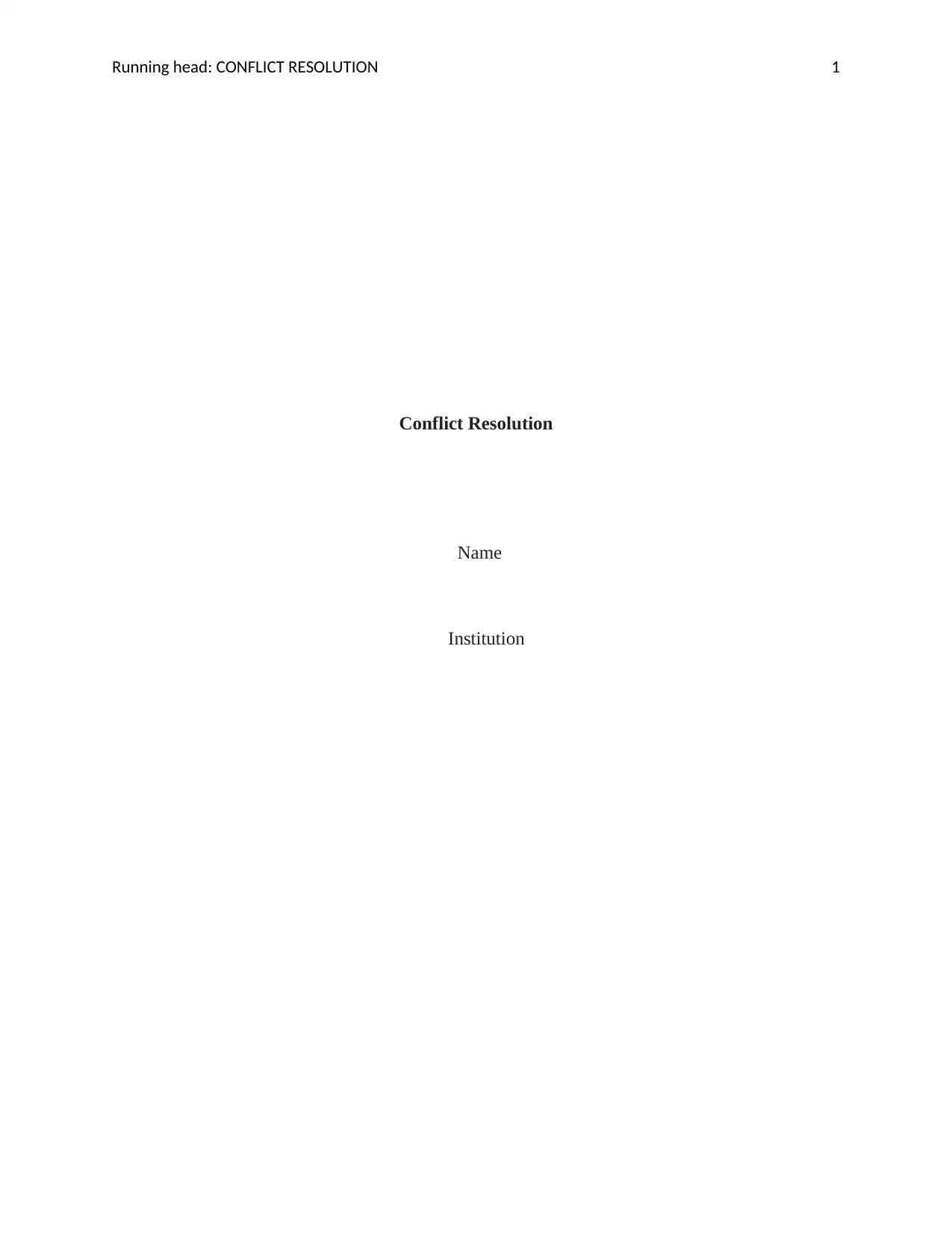
Running head: CONFLICT RESOLUTION 1
Conflict Resolution
Name
Institution
Conflict Resolution
Name
Institution
Paraphrase This Document
Need a fresh take? Get an instant paraphrase of this document with our AI Paraphraser
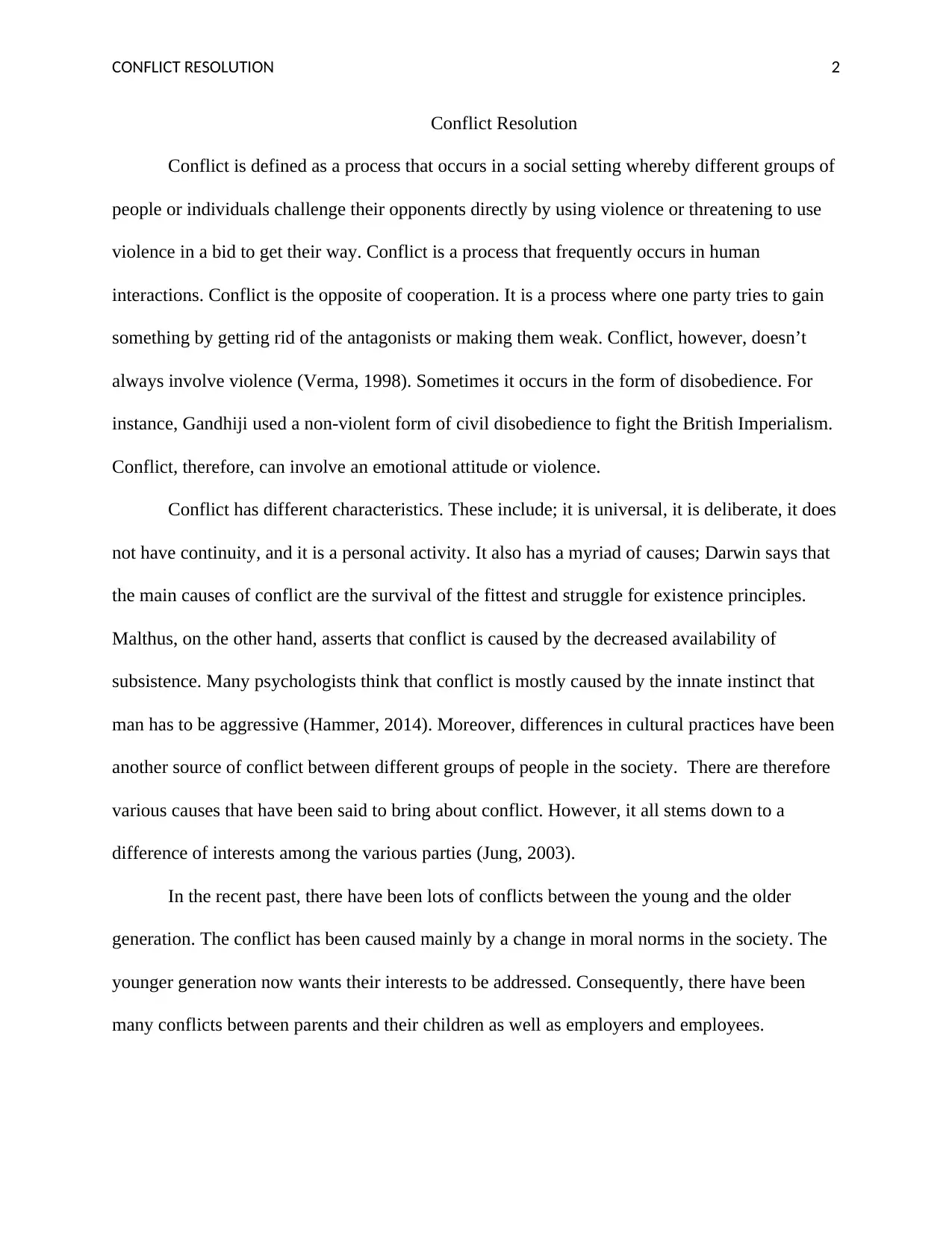
CONFLICT RESOLUTION 2
Conflict Resolution
Conflict is defined as a process that occurs in a social setting whereby different groups of
people or individuals challenge their opponents directly by using violence or threatening to use
violence in a bid to get their way. Conflict is a process that frequently occurs in human
interactions. Conflict is the opposite of cooperation. It is a process where one party tries to gain
something by getting rid of the antagonists or making them weak. Conflict, however, doesn’t
always involve violence (Verma, 1998). Sometimes it occurs in the form of disobedience. For
instance, Gandhiji used a non-violent form of civil disobedience to fight the British Imperialism.
Conflict, therefore, can involve an emotional attitude or violence.
Conflict has different characteristics. These include; it is universal, it is deliberate, it does
not have continuity, and it is a personal activity. It also has a myriad of causes; Darwin says that
the main causes of conflict are the survival of the fittest and struggle for existence principles.
Malthus, on the other hand, asserts that conflict is caused by the decreased availability of
subsistence. Many psychologists think that conflict is mostly caused by the innate instinct that
man has to be aggressive (Hammer, 2014). Moreover, differences in cultural practices have been
another source of conflict between different groups of people in the society. There are therefore
various causes that have been said to bring about conflict. However, it all stems down to a
difference of interests among the various parties (Jung, 2003).
In the recent past, there have been lots of conflicts between the young and the older
generation. The conflict has been caused mainly by a change in moral norms in the society. The
younger generation now wants their interests to be addressed. Consequently, there have been
many conflicts between parents and their children as well as employers and employees.
Conflict Resolution
Conflict is defined as a process that occurs in a social setting whereby different groups of
people or individuals challenge their opponents directly by using violence or threatening to use
violence in a bid to get their way. Conflict is a process that frequently occurs in human
interactions. Conflict is the opposite of cooperation. It is a process where one party tries to gain
something by getting rid of the antagonists or making them weak. Conflict, however, doesn’t
always involve violence (Verma, 1998). Sometimes it occurs in the form of disobedience. For
instance, Gandhiji used a non-violent form of civil disobedience to fight the British Imperialism.
Conflict, therefore, can involve an emotional attitude or violence.
Conflict has different characteristics. These include; it is universal, it is deliberate, it does
not have continuity, and it is a personal activity. It also has a myriad of causes; Darwin says that
the main causes of conflict are the survival of the fittest and struggle for existence principles.
Malthus, on the other hand, asserts that conflict is caused by the decreased availability of
subsistence. Many psychologists think that conflict is mostly caused by the innate instinct that
man has to be aggressive (Hammer, 2014). Moreover, differences in cultural practices have been
another source of conflict between different groups of people in the society. There are therefore
various causes that have been said to bring about conflict. However, it all stems down to a
difference of interests among the various parties (Jung, 2003).
In the recent past, there have been lots of conflicts between the young and the older
generation. The conflict has been caused mainly by a change in moral norms in the society. The
younger generation now wants their interests to be addressed. Consequently, there have been
many conflicts between parents and their children as well as employers and employees.
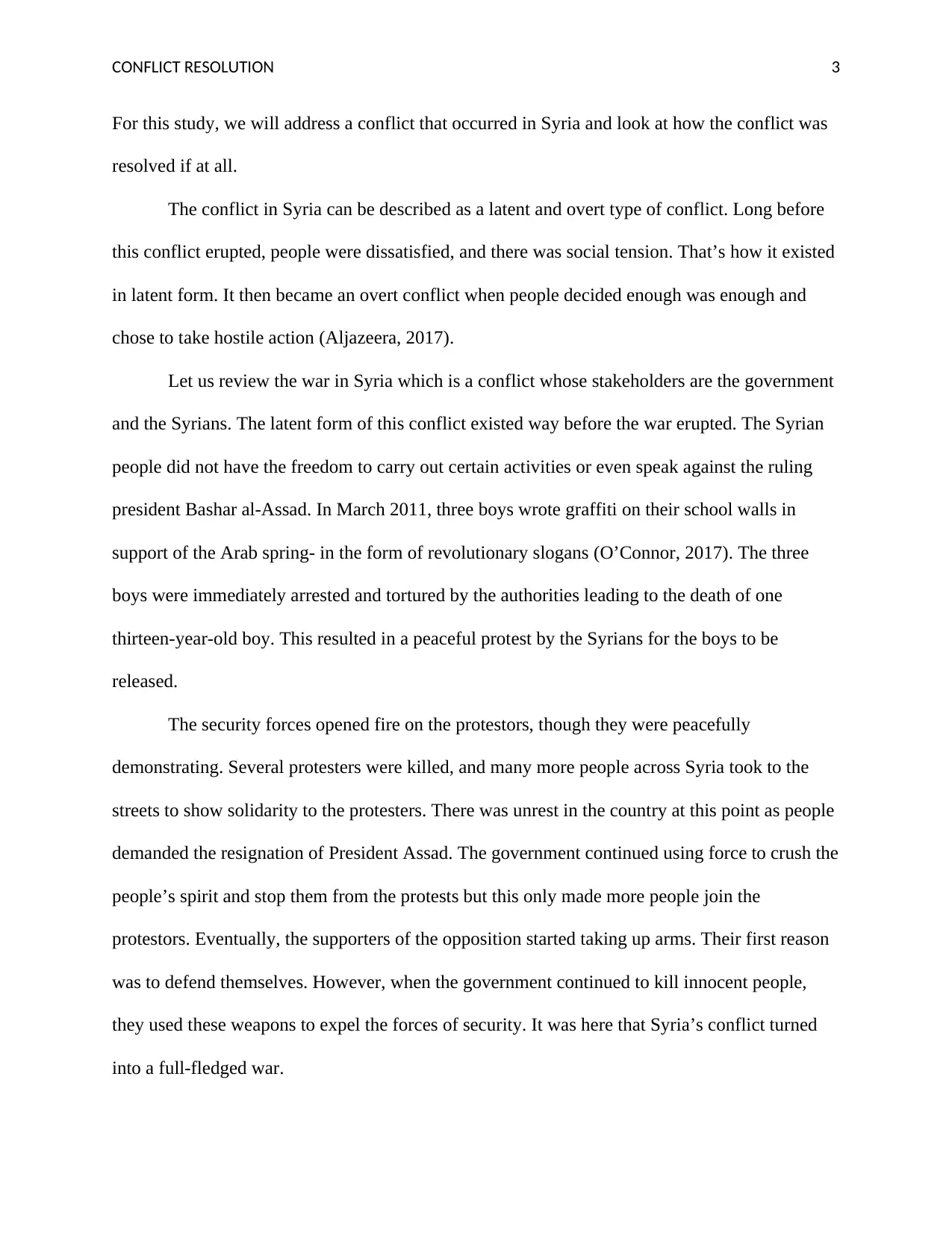
CONFLICT RESOLUTION 3
For this study, we will address a conflict that occurred in Syria and look at how the conflict was
resolved if at all.
The conflict in Syria can be described as a latent and overt type of conflict. Long before
this conflict erupted, people were dissatisfied, and there was social tension. That’s how it existed
in latent form. It then became an overt conflict when people decided enough was enough and
chose to take hostile action (Aljazeera, 2017).
Let us review the war in Syria which is a conflict whose stakeholders are the government
and the Syrians. The latent form of this conflict existed way before the war erupted. The Syrian
people did not have the freedom to carry out certain activities or even speak against the ruling
president Bashar al-Assad. In March 2011, three boys wrote graffiti on their school walls in
support of the Arab spring- in the form of revolutionary slogans (O’Connor, 2017). The three
boys were immediately arrested and tortured by the authorities leading to the death of one
thirteen-year-old boy. This resulted in a peaceful protest by the Syrians for the boys to be
released.
The security forces opened fire on the protestors, though they were peacefully
demonstrating. Several protesters were killed, and many more people across Syria took to the
streets to show solidarity to the protesters. There was unrest in the country at this point as people
demanded the resignation of President Assad. The government continued using force to crush the
people’s spirit and stop them from the protests but this only made more people join the
protestors. Eventually, the supporters of the opposition started taking up arms. Their first reason
was to defend themselves. However, when the government continued to kill innocent people,
they used these weapons to expel the forces of security. It was here that Syria’s conflict turned
into a full-fledged war.
For this study, we will address a conflict that occurred in Syria and look at how the conflict was
resolved if at all.
The conflict in Syria can be described as a latent and overt type of conflict. Long before
this conflict erupted, people were dissatisfied, and there was social tension. That’s how it existed
in latent form. It then became an overt conflict when people decided enough was enough and
chose to take hostile action (Aljazeera, 2017).
Let us review the war in Syria which is a conflict whose stakeholders are the government
and the Syrians. The latent form of this conflict existed way before the war erupted. The Syrian
people did not have the freedom to carry out certain activities or even speak against the ruling
president Bashar al-Assad. In March 2011, three boys wrote graffiti on their school walls in
support of the Arab spring- in the form of revolutionary slogans (O’Connor, 2017). The three
boys were immediately arrested and tortured by the authorities leading to the death of one
thirteen-year-old boy. This resulted in a peaceful protest by the Syrians for the boys to be
released.
The security forces opened fire on the protestors, though they were peacefully
demonstrating. Several protesters were killed, and many more people across Syria took to the
streets to show solidarity to the protesters. There was unrest in the country at this point as people
demanded the resignation of President Assad. The government continued using force to crush the
people’s spirit and stop them from the protests but this only made more people join the
protestors. Eventually, the supporters of the opposition started taking up arms. Their first reason
was to defend themselves. However, when the government continued to kill innocent people,
they used these weapons to expel the forces of security. It was here that Syria’s conflict turned
into a full-fledged war.
⊘ This is a preview!⊘
Do you want full access?
Subscribe today to unlock all pages.

Trusted by 1+ million students worldwide
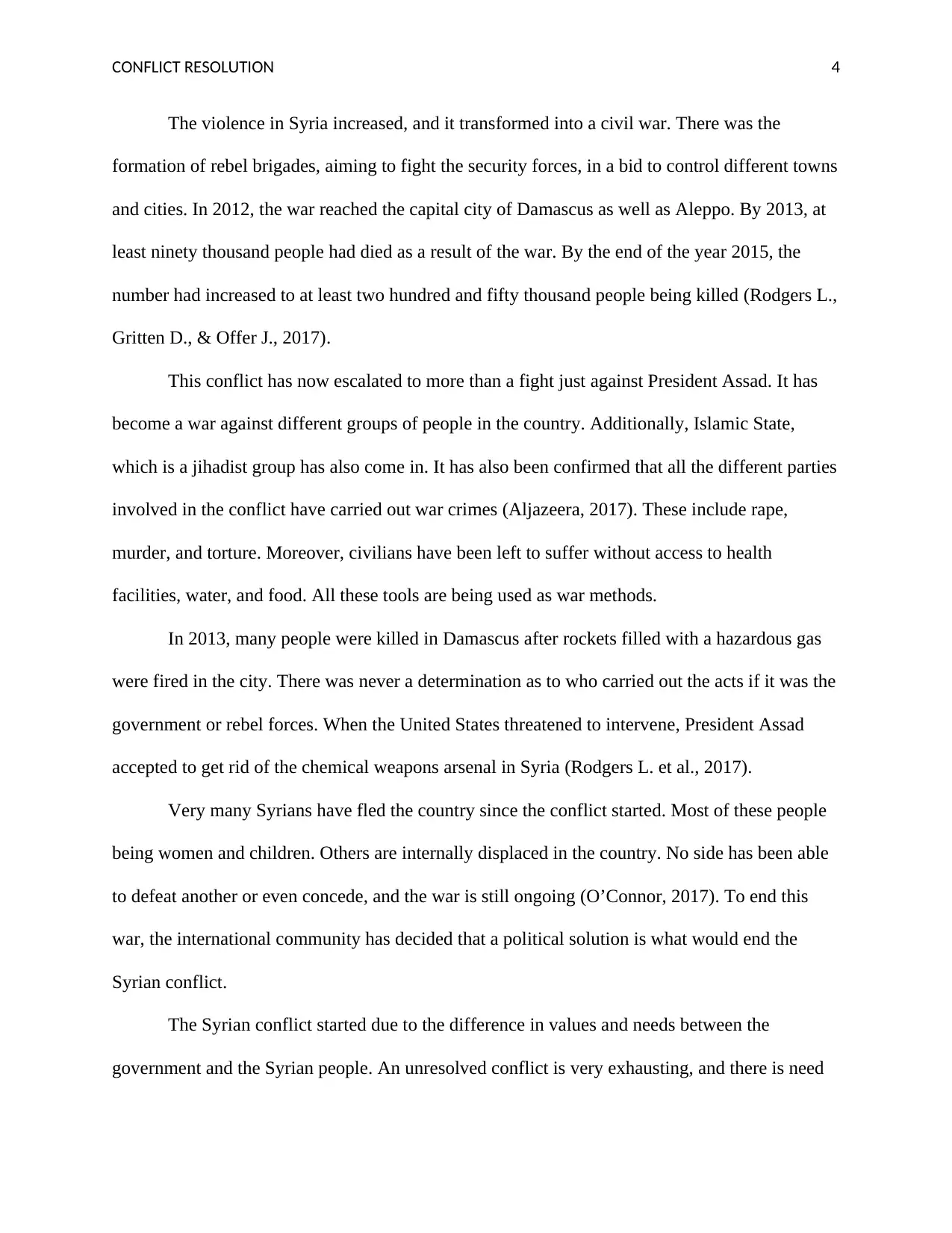
CONFLICT RESOLUTION 4
The violence in Syria increased, and it transformed into a civil war. There was the
formation of rebel brigades, aiming to fight the security forces, in a bid to control different towns
and cities. In 2012, the war reached the capital city of Damascus as well as Aleppo. By 2013, at
least ninety thousand people had died as a result of the war. By the end of the year 2015, the
number had increased to at least two hundred and fifty thousand people being killed (Rodgers L.,
Gritten D., & Offer J., 2017).
This conflict has now escalated to more than a fight just against President Assad. It has
become a war against different groups of people in the country. Additionally, Islamic State,
which is a jihadist group has also come in. It has also been confirmed that all the different parties
involved in the conflict have carried out war crimes (Aljazeera, 2017). These include rape,
murder, and torture. Moreover, civilians have been left to suffer without access to health
facilities, water, and food. All these tools are being used as war methods.
In 2013, many people were killed in Damascus after rockets filled with a hazardous gas
were fired in the city. There was never a determination as to who carried out the acts if it was the
government or rebel forces. When the United States threatened to intervene, President Assad
accepted to get rid of the chemical weapons arsenal in Syria (Rodgers L. et al., 2017).
Very many Syrians have fled the country since the conflict started. Most of these people
being women and children. Others are internally displaced in the country. No side has been able
to defeat another or even concede, and the war is still ongoing (O’Connor, 2017). To end this
war, the international community has decided that a political solution is what would end the
Syrian conflict.
The Syrian conflict started due to the difference in values and needs between the
government and the Syrian people. An unresolved conflict is very exhausting, and there is need
The violence in Syria increased, and it transformed into a civil war. There was the
formation of rebel brigades, aiming to fight the security forces, in a bid to control different towns
and cities. In 2012, the war reached the capital city of Damascus as well as Aleppo. By 2013, at
least ninety thousand people had died as a result of the war. By the end of the year 2015, the
number had increased to at least two hundred and fifty thousand people being killed (Rodgers L.,
Gritten D., & Offer J., 2017).
This conflict has now escalated to more than a fight just against President Assad. It has
become a war against different groups of people in the country. Additionally, Islamic State,
which is a jihadist group has also come in. It has also been confirmed that all the different parties
involved in the conflict have carried out war crimes (Aljazeera, 2017). These include rape,
murder, and torture. Moreover, civilians have been left to suffer without access to health
facilities, water, and food. All these tools are being used as war methods.
In 2013, many people were killed in Damascus after rockets filled with a hazardous gas
were fired in the city. There was never a determination as to who carried out the acts if it was the
government or rebel forces. When the United States threatened to intervene, President Assad
accepted to get rid of the chemical weapons arsenal in Syria (Rodgers L. et al., 2017).
Very many Syrians have fled the country since the conflict started. Most of these people
being women and children. Others are internally displaced in the country. No side has been able
to defeat another or even concede, and the war is still ongoing (O’Connor, 2017). To end this
war, the international community has decided that a political solution is what would end the
Syrian conflict.
The Syrian conflict started due to the difference in values and needs between the
government and the Syrian people. An unresolved conflict is very exhausting, and there is need
Paraphrase This Document
Need a fresh take? Get an instant paraphrase of this document with our AI Paraphraser
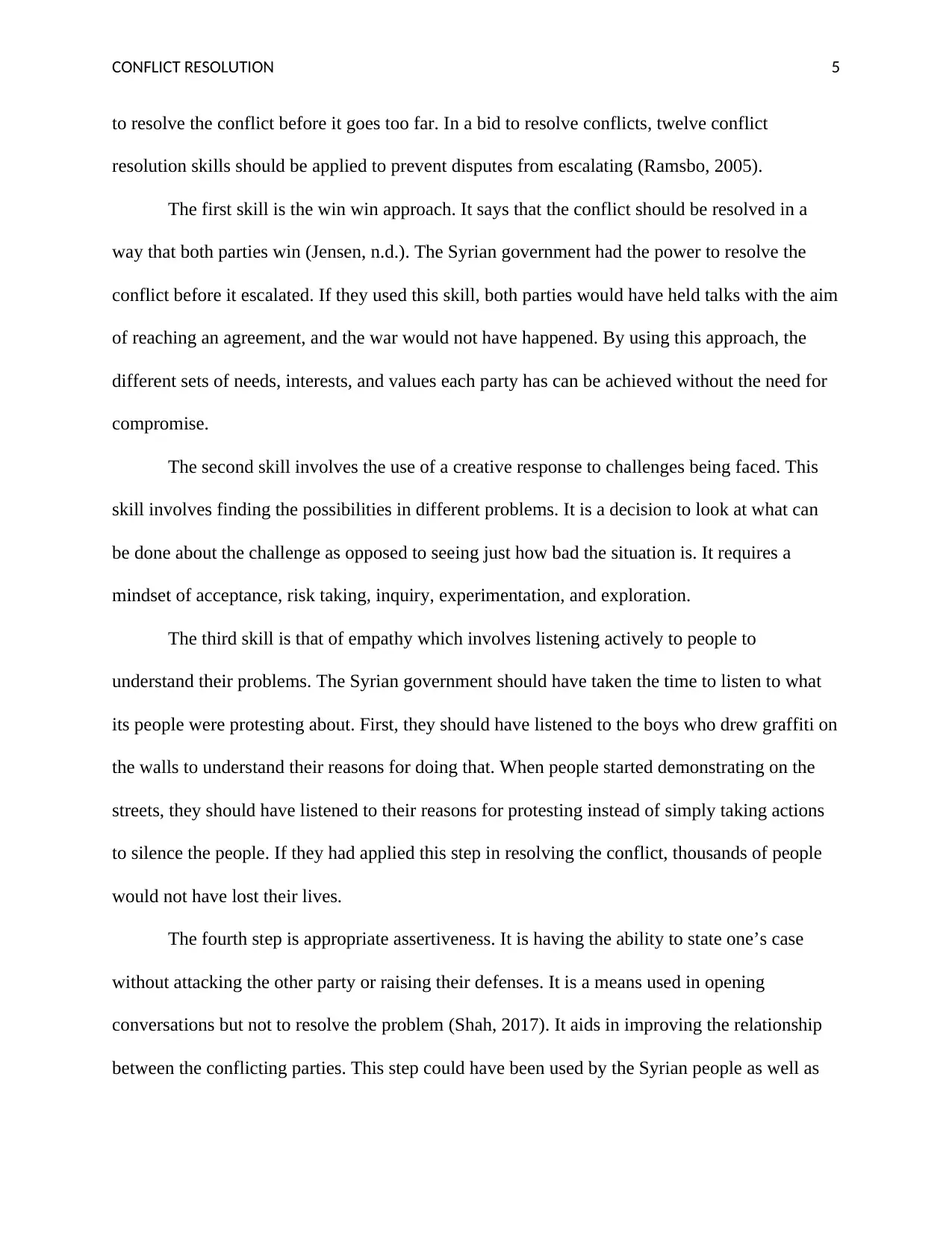
CONFLICT RESOLUTION 5
to resolve the conflict before it goes too far. In a bid to resolve conflicts, twelve conflict
resolution skills should be applied to prevent disputes from escalating (Ramsbo, 2005).
The first skill is the win win approach. It says that the conflict should be resolved in a
way that both parties win (Jensen, n.d.). The Syrian government had the power to resolve the
conflict before it escalated. If they used this skill, both parties would have held talks with the aim
of reaching an agreement, and the war would not have happened. By using this approach, the
different sets of needs, interests, and values each party has can be achieved without the need for
compromise.
The second skill involves the use of a creative response to challenges being faced. This
skill involves finding the possibilities in different problems. It is a decision to look at what can
be done about the challenge as opposed to seeing just how bad the situation is. It requires a
mindset of acceptance, risk taking, inquiry, experimentation, and exploration.
The third skill is that of empathy which involves listening actively to people to
understand their problems. The Syrian government should have taken the time to listen to what
its people were protesting about. First, they should have listened to the boys who drew graffiti on
the walls to understand their reasons for doing that. When people started demonstrating on the
streets, they should have listened to their reasons for protesting instead of simply taking actions
to silence the people. If they had applied this step in resolving the conflict, thousands of people
would not have lost their lives.
The fourth step is appropriate assertiveness. It is having the ability to state one’s case
without attacking the other party or raising their defenses. It is a means used in opening
conversations but not to resolve the problem (Shah, 2017). It aids in improving the relationship
between the conflicting parties. This step could have been used by the Syrian people as well as
to resolve the conflict before it goes too far. In a bid to resolve conflicts, twelve conflict
resolution skills should be applied to prevent disputes from escalating (Ramsbo, 2005).
The first skill is the win win approach. It says that the conflict should be resolved in a
way that both parties win (Jensen, n.d.). The Syrian government had the power to resolve the
conflict before it escalated. If they used this skill, both parties would have held talks with the aim
of reaching an agreement, and the war would not have happened. By using this approach, the
different sets of needs, interests, and values each party has can be achieved without the need for
compromise.
The second skill involves the use of a creative response to challenges being faced. This
skill involves finding the possibilities in different problems. It is a decision to look at what can
be done about the challenge as opposed to seeing just how bad the situation is. It requires a
mindset of acceptance, risk taking, inquiry, experimentation, and exploration.
The third skill is that of empathy which involves listening actively to people to
understand their problems. The Syrian government should have taken the time to listen to what
its people were protesting about. First, they should have listened to the boys who drew graffiti on
the walls to understand their reasons for doing that. When people started demonstrating on the
streets, they should have listened to their reasons for protesting instead of simply taking actions
to silence the people. If they had applied this step in resolving the conflict, thousands of people
would not have lost their lives.
The fourth step is appropriate assertiveness. It is having the ability to state one’s case
without attacking the other party or raising their defenses. It is a means used in opening
conversations but not to resolve the problem (Shah, 2017). It aids in improving the relationship
between the conflicting parties. This step could have been used by the Syrian people as well as
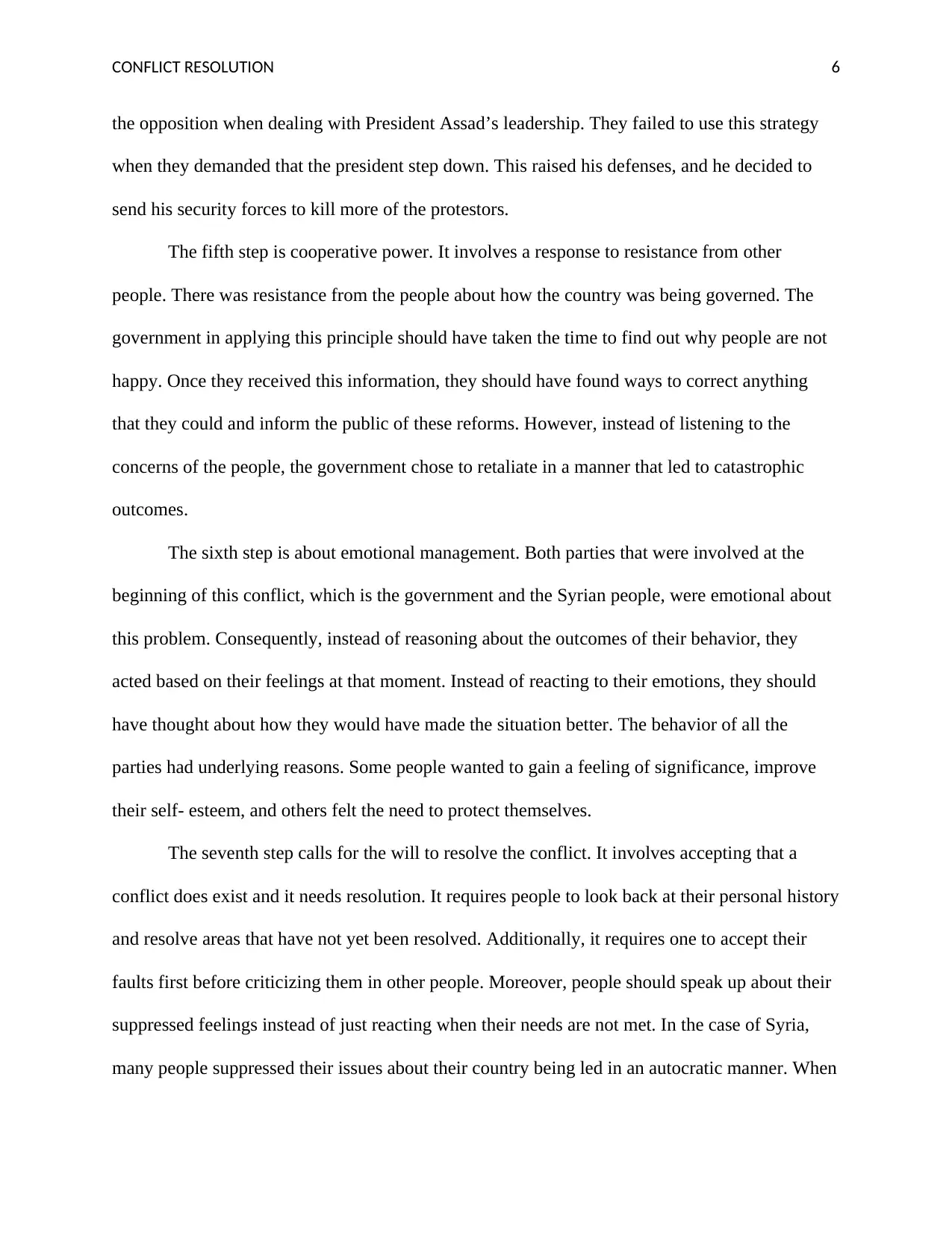
CONFLICT RESOLUTION 6
the opposition when dealing with President Assad’s leadership. They failed to use this strategy
when they demanded that the president step down. This raised his defenses, and he decided to
send his security forces to kill more of the protestors.
The fifth step is cooperative power. It involves a response to resistance from other
people. There was resistance from the people about how the country was being governed. The
government in applying this principle should have taken the time to find out why people are not
happy. Once they received this information, they should have found ways to correct anything
that they could and inform the public of these reforms. However, instead of listening to the
concerns of the people, the government chose to retaliate in a manner that led to catastrophic
outcomes.
The sixth step is about emotional management. Both parties that were involved at the
beginning of this conflict, which is the government and the Syrian people, were emotional about
this problem. Consequently, instead of reasoning about the outcomes of their behavior, they
acted based on their feelings at that moment. Instead of reacting to their emotions, they should
have thought about how they would have made the situation better. The behavior of all the
parties had underlying reasons. Some people wanted to gain a feeling of significance, improve
their self- esteem, and others felt the need to protect themselves.
The seventh step calls for the will to resolve the conflict. It involves accepting that a
conflict does exist and it needs resolution. It requires people to look back at their personal history
and resolve areas that have not yet been resolved. Additionally, it requires one to accept their
faults first before criticizing them in other people. Moreover, people should speak up about their
suppressed feelings instead of just reacting when their needs are not met. In the case of Syria,
many people suppressed their issues about their country being led in an autocratic manner. When
the opposition when dealing with President Assad’s leadership. They failed to use this strategy
when they demanded that the president step down. This raised his defenses, and he decided to
send his security forces to kill more of the protestors.
The fifth step is cooperative power. It involves a response to resistance from other
people. There was resistance from the people about how the country was being governed. The
government in applying this principle should have taken the time to find out why people are not
happy. Once they received this information, they should have found ways to correct anything
that they could and inform the public of these reforms. However, instead of listening to the
concerns of the people, the government chose to retaliate in a manner that led to catastrophic
outcomes.
The sixth step is about emotional management. Both parties that were involved at the
beginning of this conflict, which is the government and the Syrian people, were emotional about
this problem. Consequently, instead of reasoning about the outcomes of their behavior, they
acted based on their feelings at that moment. Instead of reacting to their emotions, they should
have thought about how they would have made the situation better. The behavior of all the
parties had underlying reasons. Some people wanted to gain a feeling of significance, improve
their self- esteem, and others felt the need to protect themselves.
The seventh step calls for the will to resolve the conflict. It involves accepting that a
conflict does exist and it needs resolution. It requires people to look back at their personal history
and resolve areas that have not yet been resolved. Additionally, it requires one to accept their
faults first before criticizing them in other people. Moreover, people should speak up about their
suppressed feelings instead of just reacting when their needs are not met. In the case of Syria,
many people suppressed their issues about their country being led in an autocratic manner. When
⊘ This is a preview!⊘
Do you want full access?
Subscribe today to unlock all pages.

Trusted by 1+ million students worldwide
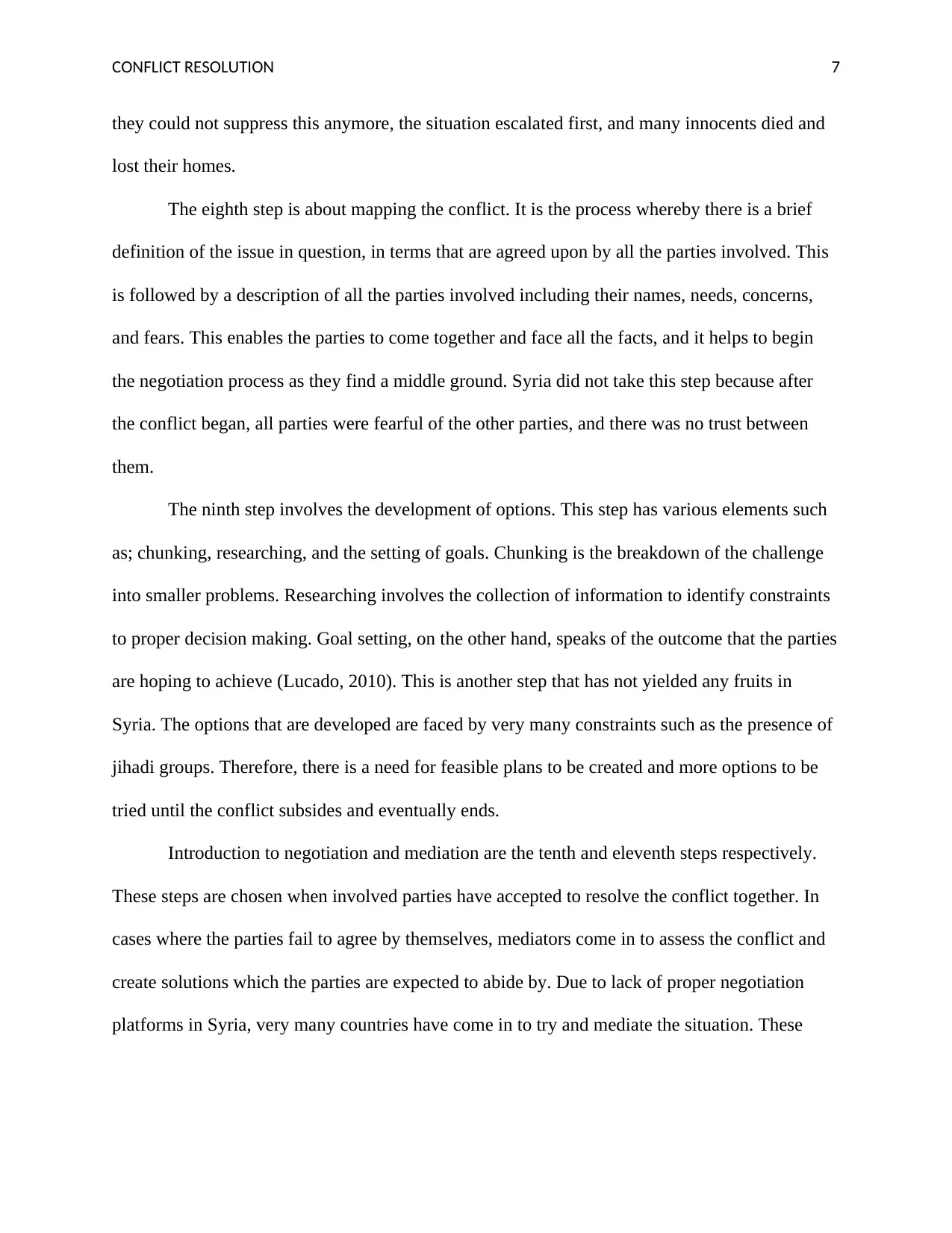
CONFLICT RESOLUTION 7
they could not suppress this anymore, the situation escalated first, and many innocents died and
lost their homes.
The eighth step is about mapping the conflict. It is the process whereby there is a brief
definition of the issue in question, in terms that are agreed upon by all the parties involved. This
is followed by a description of all the parties involved including their names, needs, concerns,
and fears. This enables the parties to come together and face all the facts, and it helps to begin
the negotiation process as they find a middle ground. Syria did not take this step because after
the conflict began, all parties were fearful of the other parties, and there was no trust between
them.
The ninth step involves the development of options. This step has various elements such
as; chunking, researching, and the setting of goals. Chunking is the breakdown of the challenge
into smaller problems. Researching involves the collection of information to identify constraints
to proper decision making. Goal setting, on the other hand, speaks of the outcome that the parties
are hoping to achieve (Lucado, 2010). This is another step that has not yielded any fruits in
Syria. The options that are developed are faced by very many constraints such as the presence of
jihadi groups. Therefore, there is a need for feasible plans to be created and more options to be
tried until the conflict subsides and eventually ends.
Introduction to negotiation and mediation are the tenth and eleventh steps respectively.
These steps are chosen when involved parties have accepted to resolve the conflict together. In
cases where the parties fail to agree by themselves, mediators come in to assess the conflict and
create solutions which the parties are expected to abide by. Due to lack of proper negotiation
platforms in Syria, very many countries have come in to try and mediate the situation. These
they could not suppress this anymore, the situation escalated first, and many innocents died and
lost their homes.
The eighth step is about mapping the conflict. It is the process whereby there is a brief
definition of the issue in question, in terms that are agreed upon by all the parties involved. This
is followed by a description of all the parties involved including their names, needs, concerns,
and fears. This enables the parties to come together and face all the facts, and it helps to begin
the negotiation process as they find a middle ground. Syria did not take this step because after
the conflict began, all parties were fearful of the other parties, and there was no trust between
them.
The ninth step involves the development of options. This step has various elements such
as; chunking, researching, and the setting of goals. Chunking is the breakdown of the challenge
into smaller problems. Researching involves the collection of information to identify constraints
to proper decision making. Goal setting, on the other hand, speaks of the outcome that the parties
are hoping to achieve (Lucado, 2010). This is another step that has not yielded any fruits in
Syria. The options that are developed are faced by very many constraints such as the presence of
jihadi groups. Therefore, there is a need for feasible plans to be created and more options to be
tried until the conflict subsides and eventually ends.
Introduction to negotiation and mediation are the tenth and eleventh steps respectively.
These steps are chosen when involved parties have accepted to resolve the conflict together. In
cases where the parties fail to agree by themselves, mediators come in to assess the conflict and
create solutions which the parties are expected to abide by. Due to lack of proper negotiation
platforms in Syria, very many countries have come in to try and mediate the situation. These
Paraphrase This Document
Need a fresh take? Get an instant paraphrase of this document with our AI Paraphraser
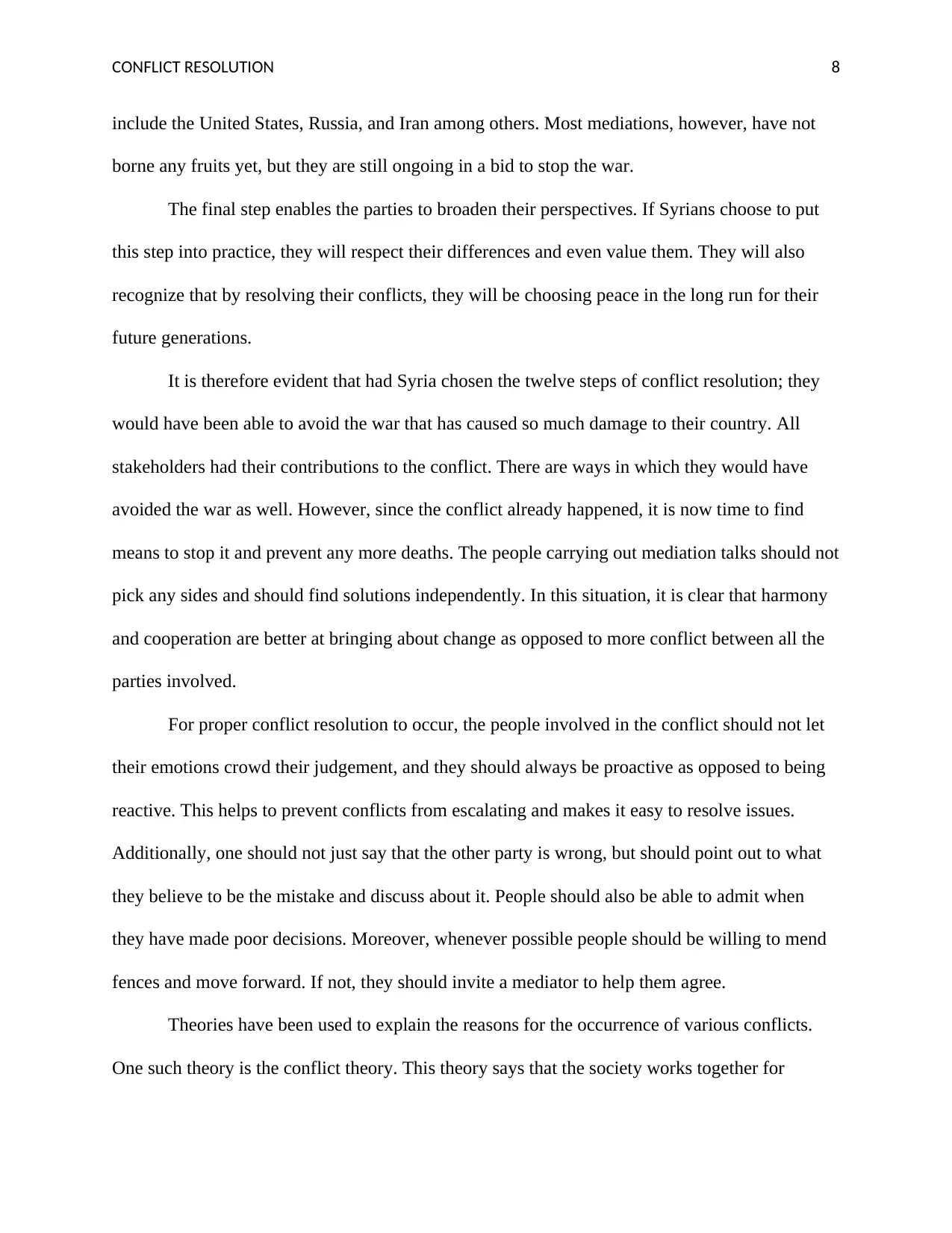
CONFLICT RESOLUTION 8
include the United States, Russia, and Iran among others. Most mediations, however, have not
borne any fruits yet, but they are still ongoing in a bid to stop the war.
The final step enables the parties to broaden their perspectives. If Syrians choose to put
this step into practice, they will respect their differences and even value them. They will also
recognize that by resolving their conflicts, they will be choosing peace in the long run for their
future generations.
It is therefore evident that had Syria chosen the twelve steps of conflict resolution; they
would have been able to avoid the war that has caused so much damage to their country. All
stakeholders had their contributions to the conflict. There are ways in which they would have
avoided the war as well. However, since the conflict already happened, it is now time to find
means to stop it and prevent any more deaths. The people carrying out mediation talks should not
pick any sides and should find solutions independently. In this situation, it is clear that harmony
and cooperation are better at bringing about change as opposed to more conflict between all the
parties involved.
For proper conflict resolution to occur, the people involved in the conflict should not let
their emotions crowd their judgement, and they should always be proactive as opposed to being
reactive. This helps to prevent conflicts from escalating and makes it easy to resolve issues.
Additionally, one should not just say that the other party is wrong, but should point out to what
they believe to be the mistake and discuss about it. People should also be able to admit when
they have made poor decisions. Moreover, whenever possible people should be willing to mend
fences and move forward. If not, they should invite a mediator to help them agree.
Theories have been used to explain the reasons for the occurrence of various conflicts.
One such theory is the conflict theory. This theory says that the society works together for
include the United States, Russia, and Iran among others. Most mediations, however, have not
borne any fruits yet, but they are still ongoing in a bid to stop the war.
The final step enables the parties to broaden their perspectives. If Syrians choose to put
this step into practice, they will respect their differences and even value them. They will also
recognize that by resolving their conflicts, they will be choosing peace in the long run for their
future generations.
It is therefore evident that had Syria chosen the twelve steps of conflict resolution; they
would have been able to avoid the war that has caused so much damage to their country. All
stakeholders had their contributions to the conflict. There are ways in which they would have
avoided the war as well. However, since the conflict already happened, it is now time to find
means to stop it and prevent any more deaths. The people carrying out mediation talks should not
pick any sides and should find solutions independently. In this situation, it is clear that harmony
and cooperation are better at bringing about change as opposed to more conflict between all the
parties involved.
For proper conflict resolution to occur, the people involved in the conflict should not let
their emotions crowd their judgement, and they should always be proactive as opposed to being
reactive. This helps to prevent conflicts from escalating and makes it easy to resolve issues.
Additionally, one should not just say that the other party is wrong, but should point out to what
they believe to be the mistake and discuss about it. People should also be able to admit when
they have made poor decisions. Moreover, whenever possible people should be willing to mend
fences and move forward. If not, they should invite a mediator to help them agree.
Theories have been used to explain the reasons for the occurrence of various conflicts.
One such theory is the conflict theory. This theory says that the society works together for
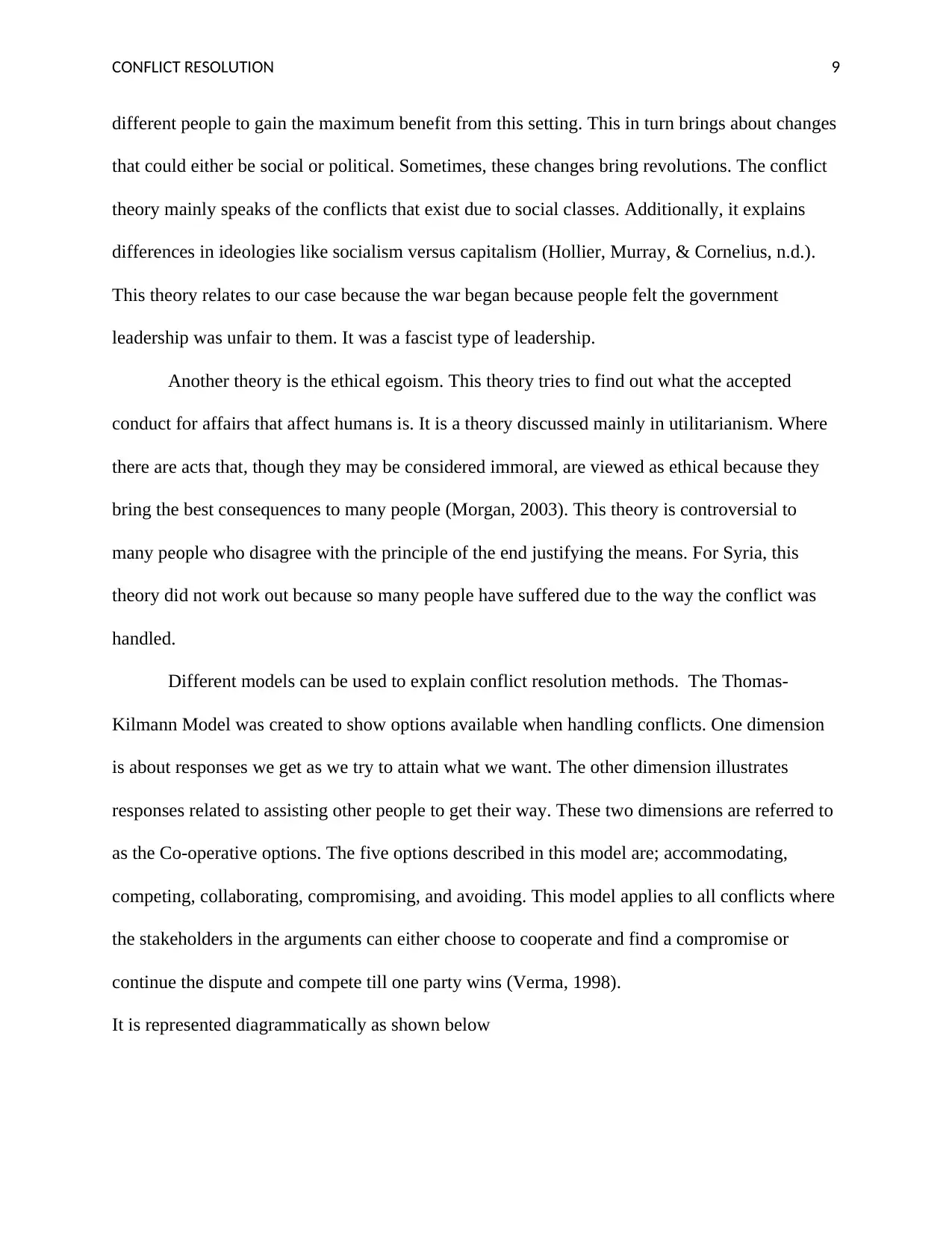
CONFLICT RESOLUTION 9
different people to gain the maximum benefit from this setting. This in turn brings about changes
that could either be social or political. Sometimes, these changes bring revolutions. The conflict
theory mainly speaks of the conflicts that exist due to social classes. Additionally, it explains
differences in ideologies like socialism versus capitalism (Hollier, Murray, & Cornelius, n.d.).
This theory relates to our case because the war began because people felt the government
leadership was unfair to them. It was a fascist type of leadership.
Another theory is the ethical egoism. This theory tries to find out what the accepted
conduct for affairs that affect humans is. It is a theory discussed mainly in utilitarianism. Where
there are acts that, though they may be considered immoral, are viewed as ethical because they
bring the best consequences to many people (Morgan, 2003). This theory is controversial to
many people who disagree with the principle of the end justifying the means. For Syria, this
theory did not work out because so many people have suffered due to the way the conflict was
handled.
Different models can be used to explain conflict resolution methods. The Thomas-
Kilmann Model was created to show options available when handling conflicts. One dimension
is about responses we get as we try to attain what we want. The other dimension illustrates
responses related to assisting other people to get their way. These two dimensions are referred to
as the Co-operative options. The five options described in this model are; accommodating,
competing, collaborating, compromising, and avoiding. This model applies to all conflicts where
the stakeholders in the arguments can either choose to cooperate and find a compromise or
continue the dispute and compete till one party wins (Verma, 1998).
It is represented diagrammatically as shown below
different people to gain the maximum benefit from this setting. This in turn brings about changes
that could either be social or political. Sometimes, these changes bring revolutions. The conflict
theory mainly speaks of the conflicts that exist due to social classes. Additionally, it explains
differences in ideologies like socialism versus capitalism (Hollier, Murray, & Cornelius, n.d.).
This theory relates to our case because the war began because people felt the government
leadership was unfair to them. It was a fascist type of leadership.
Another theory is the ethical egoism. This theory tries to find out what the accepted
conduct for affairs that affect humans is. It is a theory discussed mainly in utilitarianism. Where
there are acts that, though they may be considered immoral, are viewed as ethical because they
bring the best consequences to many people (Morgan, 2003). This theory is controversial to
many people who disagree with the principle of the end justifying the means. For Syria, this
theory did not work out because so many people have suffered due to the way the conflict was
handled.
Different models can be used to explain conflict resolution methods. The Thomas-
Kilmann Model was created to show options available when handling conflicts. One dimension
is about responses we get as we try to attain what we want. The other dimension illustrates
responses related to assisting other people to get their way. These two dimensions are referred to
as the Co-operative options. The five options described in this model are; accommodating,
competing, collaborating, compromising, and avoiding. This model applies to all conflicts where
the stakeholders in the arguments can either choose to cooperate and find a compromise or
continue the dispute and compete till one party wins (Verma, 1998).
It is represented diagrammatically as shown below
⊘ This is a preview!⊘
Do you want full access?
Subscribe today to unlock all pages.

Trusted by 1+ million students worldwide
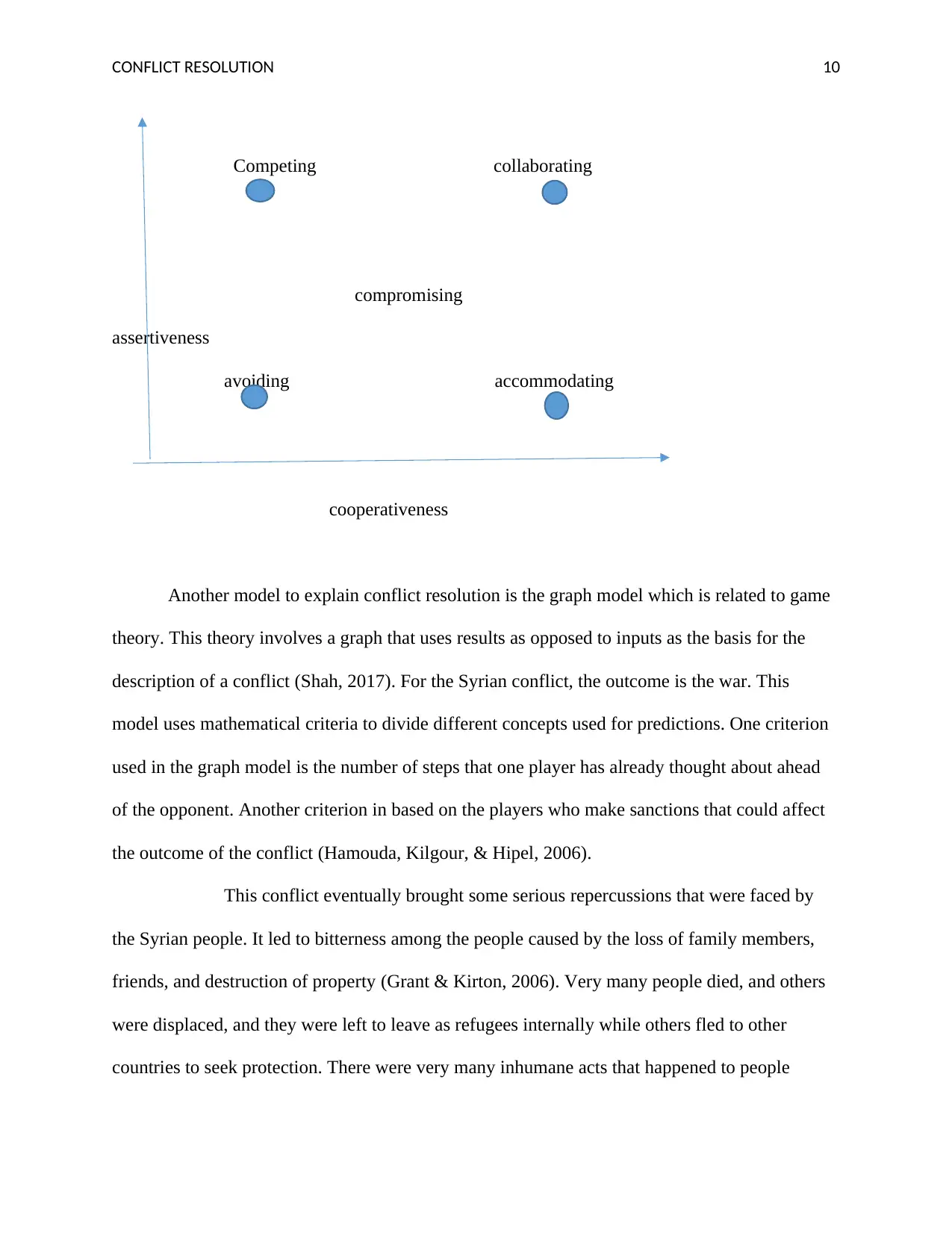
CONFLICT RESOLUTION 10
Competing collaborating
compromising
assertiveness
avoiding accommodating
cooperativeness
Another model to explain conflict resolution is the graph model which is related to game
theory. This theory involves a graph that uses results as opposed to inputs as the basis for the
description of a conflict (Shah, 2017). For the Syrian conflict, the outcome is the war. This
model uses mathematical criteria to divide different concepts used for predictions. One criterion
used in the graph model is the number of steps that one player has already thought about ahead
of the opponent. Another criterion in based on the players who make sanctions that could affect
the outcome of the conflict (Hamouda, Kilgour, & Hipel, 2006).
This conflict eventually brought some serious repercussions that were faced by
the Syrian people. It led to bitterness among the people caused by the loss of family members,
friends, and destruction of property (Grant & Kirton, 2006). Very many people died, and others
were displaced, and they were left to leave as refugees internally while others fled to other
countries to seek protection. There were very many inhumane acts that happened to people
Competing collaborating
compromising
assertiveness
avoiding accommodating
cooperativeness
Another model to explain conflict resolution is the graph model which is related to game
theory. This theory involves a graph that uses results as opposed to inputs as the basis for the
description of a conflict (Shah, 2017). For the Syrian conflict, the outcome is the war. This
model uses mathematical criteria to divide different concepts used for predictions. One criterion
used in the graph model is the number of steps that one player has already thought about ahead
of the opponent. Another criterion in based on the players who make sanctions that could affect
the outcome of the conflict (Hamouda, Kilgour, & Hipel, 2006).
This conflict eventually brought some serious repercussions that were faced by
the Syrian people. It led to bitterness among the people caused by the loss of family members,
friends, and destruction of property (Grant & Kirton, 2006). Very many people died, and others
were displaced, and they were left to leave as refugees internally while others fled to other
countries to seek protection. There were very many inhumane acts that happened to people
Paraphrase This Document
Need a fresh take? Get an instant paraphrase of this document with our AI Paraphraser
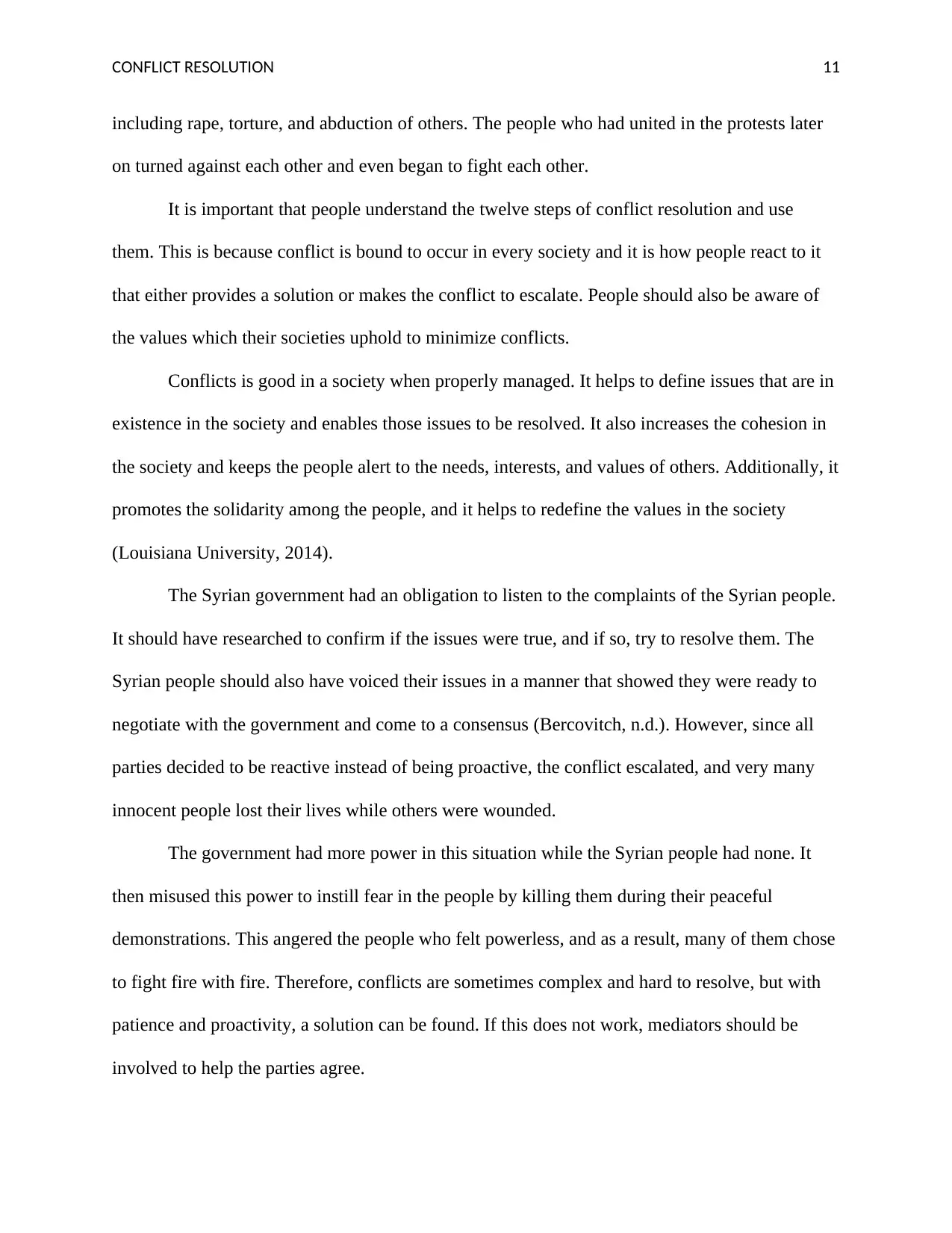
CONFLICT RESOLUTION 11
including rape, torture, and abduction of others. The people who had united in the protests later
on turned against each other and even began to fight each other.
It is important that people understand the twelve steps of conflict resolution and use
them. This is because conflict is bound to occur in every society and it is how people react to it
that either provides a solution or makes the conflict to escalate. People should also be aware of
the values which their societies uphold to minimize conflicts.
Conflicts is good in a society when properly managed. It helps to define issues that are in
existence in the society and enables those issues to be resolved. It also increases the cohesion in
the society and keeps the people alert to the needs, interests, and values of others. Additionally, it
promotes the solidarity among the people, and it helps to redefine the values in the society
(Louisiana University, 2014).
The Syrian government had an obligation to listen to the complaints of the Syrian people.
It should have researched to confirm if the issues were true, and if so, try to resolve them. The
Syrian people should also have voiced their issues in a manner that showed they were ready to
negotiate with the government and come to a consensus (Bercovitch, n.d.). However, since all
parties decided to be reactive instead of being proactive, the conflict escalated, and very many
innocent people lost their lives while others were wounded.
The government had more power in this situation while the Syrian people had none. It
then misused this power to instill fear in the people by killing them during their peaceful
demonstrations. This angered the people who felt powerless, and as a result, many of them chose
to fight fire with fire. Therefore, conflicts are sometimes complex and hard to resolve, but with
patience and proactivity, a solution can be found. If this does not work, mediators should be
involved to help the parties agree.
including rape, torture, and abduction of others. The people who had united in the protests later
on turned against each other and even began to fight each other.
It is important that people understand the twelve steps of conflict resolution and use
them. This is because conflict is bound to occur in every society and it is how people react to it
that either provides a solution or makes the conflict to escalate. People should also be aware of
the values which their societies uphold to minimize conflicts.
Conflicts is good in a society when properly managed. It helps to define issues that are in
existence in the society and enables those issues to be resolved. It also increases the cohesion in
the society and keeps the people alert to the needs, interests, and values of others. Additionally, it
promotes the solidarity among the people, and it helps to redefine the values in the society
(Louisiana University, 2014).
The Syrian government had an obligation to listen to the complaints of the Syrian people.
It should have researched to confirm if the issues were true, and if so, try to resolve them. The
Syrian people should also have voiced their issues in a manner that showed they were ready to
negotiate with the government and come to a consensus (Bercovitch, n.d.). However, since all
parties decided to be reactive instead of being proactive, the conflict escalated, and very many
innocent people lost their lives while others were wounded.
The government had more power in this situation while the Syrian people had none. It
then misused this power to instill fear in the people by killing them during their peaceful
demonstrations. This angered the people who felt powerless, and as a result, many of them chose
to fight fire with fire. Therefore, conflicts are sometimes complex and hard to resolve, but with
patience and proactivity, a solution can be found. If this does not work, mediators should be
involved to help the parties agree.
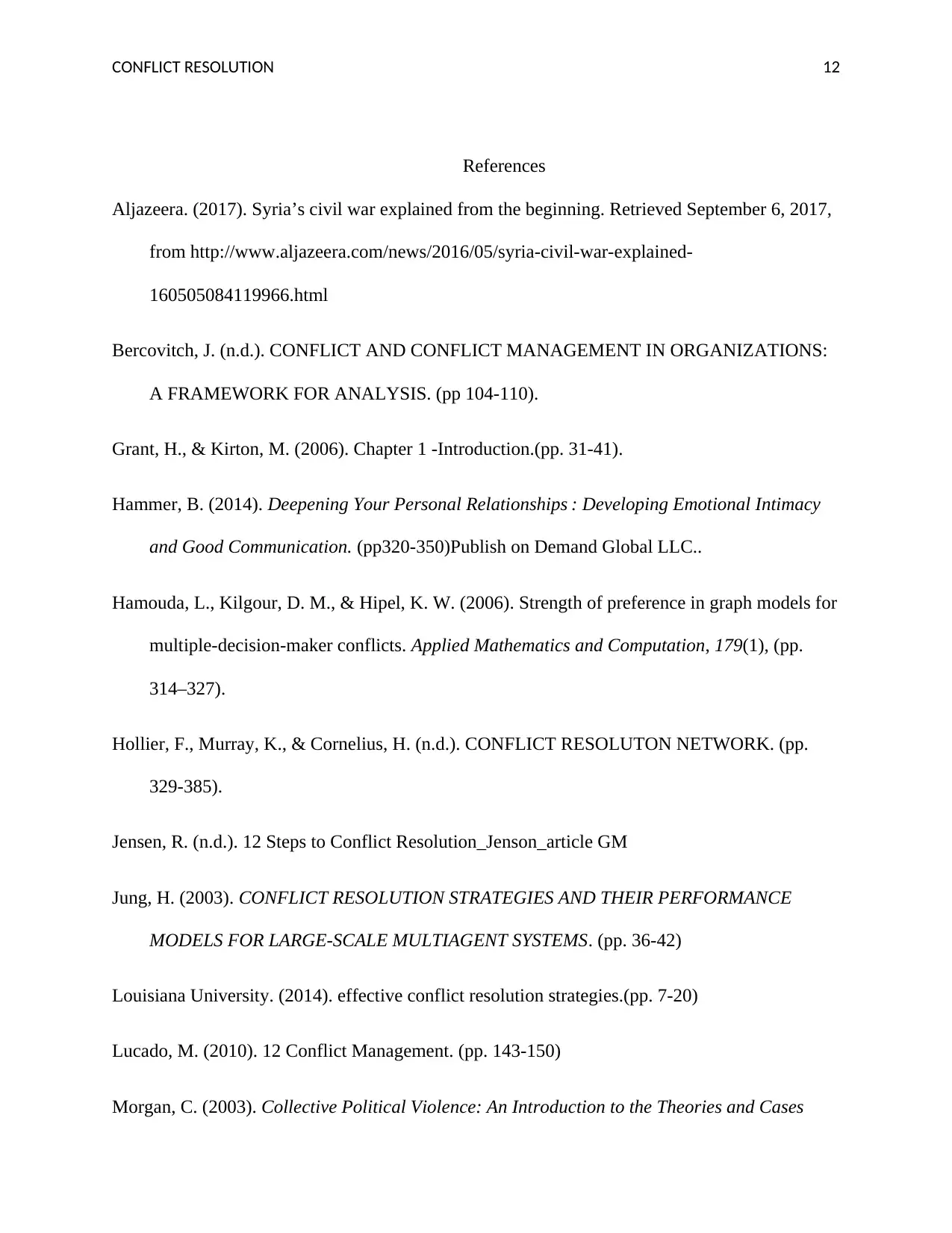
CONFLICT RESOLUTION 12
References
Aljazeera. (2017). Syria’s civil war explained from the beginning. Retrieved September 6, 2017,
from http://www.aljazeera.com/news/2016/05/syria-civil-war-explained-
160505084119966.html
Bercovitch, J. (n.d.). CONFLICT AND CONFLICT MANAGEMENT IN ORGANIZATIONS:
A FRAMEWORK FOR ANALYSIS. (pp 104-110).
Grant, H., & Kirton, M. (2006). Chapter 1 -Introduction.(pp. 31-41).
Hammer, B. (2014). Deepening Your Personal Relationships : Developing Emotional Intimacy
and Good Communication. (pp320-350)Publish on Demand Global LLC..
Hamouda, L., Kilgour, D. M., & Hipel, K. W. (2006). Strength of preference in graph models for
multiple-decision-maker conflicts. Applied Mathematics and Computation, 179(1), (pp.
314–327).
Hollier, F., Murray, K., & Cornelius, H. (n.d.). CONFLICT RESOLUTON NETWORK. (pp.
329-385).
Jensen, R. (n.d.). 12 Steps to Conflict Resolution_Jenson_article GM
Jung, H. (2003). CONFLICT RESOLUTION STRATEGIES AND THEIR PERFORMANCE
MODELS FOR LARGE-SCALE MULTIAGENT SYSTEMS. (pp. 36-42)
Louisiana University. (2014). effective conflict resolution strategies.(pp. 7-20)
Lucado, M. (2010). 12 Conflict Management. (pp. 143-150)
Morgan, C. (2003). Collective Political Violence: An Introduction to the Theories and Cases
References
Aljazeera. (2017). Syria’s civil war explained from the beginning. Retrieved September 6, 2017,
from http://www.aljazeera.com/news/2016/05/syria-civil-war-explained-
160505084119966.html
Bercovitch, J. (n.d.). CONFLICT AND CONFLICT MANAGEMENT IN ORGANIZATIONS:
A FRAMEWORK FOR ANALYSIS. (pp 104-110).
Grant, H., & Kirton, M. (2006). Chapter 1 -Introduction.(pp. 31-41).
Hammer, B. (2014). Deepening Your Personal Relationships : Developing Emotional Intimacy
and Good Communication. (pp320-350)Publish on Demand Global LLC..
Hamouda, L., Kilgour, D. M., & Hipel, K. W. (2006). Strength of preference in graph models for
multiple-decision-maker conflicts. Applied Mathematics and Computation, 179(1), (pp.
314–327).
Hollier, F., Murray, K., & Cornelius, H. (n.d.). CONFLICT RESOLUTON NETWORK. (pp.
329-385).
Jensen, R. (n.d.). 12 Steps to Conflict Resolution_Jenson_article GM
Jung, H. (2003). CONFLICT RESOLUTION STRATEGIES AND THEIR PERFORMANCE
MODELS FOR LARGE-SCALE MULTIAGENT SYSTEMS. (pp. 36-42)
Louisiana University. (2014). effective conflict resolution strategies.(pp. 7-20)
Lucado, M. (2010). 12 Conflict Management. (pp. 143-150)
Morgan, C. (2003). Collective Political Violence: An Introduction to the Theories and Cases
⊘ This is a preview!⊘
Do you want full access?
Subscribe today to unlock all pages.

Trusted by 1+ million students worldwide
1 out of 13
Related Documents
Your All-in-One AI-Powered Toolkit for Academic Success.
+13062052269
info@desklib.com
Available 24*7 on WhatsApp / Email
![[object Object]](/_next/static/media/star-bottom.7253800d.svg)
Unlock your academic potential
Copyright © 2020–2025 A2Z Services. All Rights Reserved. Developed and managed by ZUCOL.



